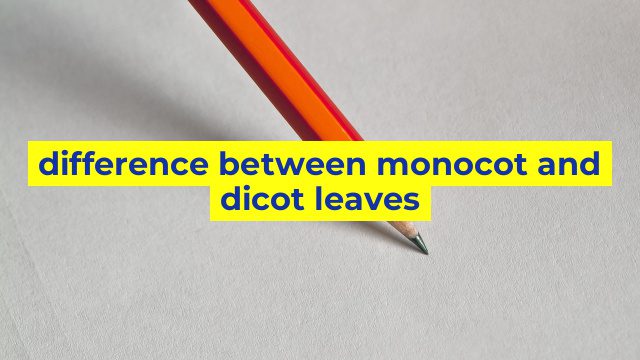The Key Differences between Monocot and Dicot Leaves
Leaves are one of the most important parts of a plant as they play a crucial role in photosynthesis. Plants have two types of leaves, monocot and dicot, which have fundamental differences in their structure and shape. In this article, we will delve deeper into the difference between monocot and dicot leaves.
What are Monocot Leaves?
Monocot leaves are a type of leaf that possess a long and narrow shape. They are characterized by parallel veins that run from the base of the leaf blade to the top. Typically, monocot leaves have smooth and straight edges with no distinct lobes or serrations.
Monocot leaves usually come in a bundle, and they are arranged in a circular shape around the stem. These leaves have a single vein, called the midrib, which runs from the base to the tip of the leaf. Examples of plants with monocot leaves include grasses, wheat, corn, rice, and lilies.
What are Dicot Leaves?
Dicot leaves, on the other hand, are broader and have a more complex venation pattern when compared to monocots. They have a network of veins that branch out from the midrib and form intricate patterns, like a spider web.
Dicot leaves usually have distinct lobes or serrations on their edges, which are absent in monocots. They are also larger in size and usually have a more defined shape. Examples of plants with dicot leaves include roses, oak trees, beans, and sunflowers.
The Main Differences between Monocot and Dicot Leaves
The main differences between monocot and dicot leaves include the following:
- Leaf Shape: Monocots have a long and narrow shape, while dicots have a broader shape with distinct lobes and serrations.
- Venation Pattern: Monocots have parallel veins, while dicots have a branching pattern of veins.
- Leaf Margin: Monocots have smooth and straight edges, while dicots have distinct lobes or serrations.
- Leaf Arrangement: Monocots have a circular arrangement of leaves around the stem, while dicots have an alternate or opposite arrangement of leaves.
- Size: Dicot leaves are usually larger in size than monocot leaves.
In conclusion, while both monocot and dicot leaves play an essential role in the survival and growth of plants, they have significant differences in their structure, shape, and arrangement. Understanding these differences can help in classifying plants and studying their anatomy.
Table difference between monocot and dicot leaves
| Features | Monocot Leaves | Dicot Leaves |
|---|---|---|
| Vein Pattern | Parallel veins | Network of veins |
| Leaf Structure | Narrow and elongated | Wider and broader |
| Vascular Bundles | Scattered throughout the leaf | Arranged in a circular pattern |
| Stomata | Scattered on both upper and lower surfaces | Mostly on the lower surface |
| Leaf Margin | Usually entire or with small teeth | Varied – entire, serrate, or lobed |
